
9
Figure 8
C. Connect Pipe Adapter or Increaser Adapter
to stove: Due to the variety of different stove
collars, the Pipe Adapter will need high-
temperature non-hardening sealant in order to
achieve a leak-free connection. .
D. Connect Pipe Sections. Attach Secure
Pellet Pipe Sections by pushing male and
female ends of pipe together and twisting until
pipe is in locked position (Figure 4). Pipe
sections do not require any sealant; however
in certain instances high temp silicone sealant
may be used. Seal connection where the
inner liners overlap for best results (Figure 5).
Screws are not needed, but 1/4” screws can
be used if desired, however, be sure you do
not penetrate the inner liner.
E. When the pipe passes through the Ceiling
Support Firestop Spacer at ceiling, tighten
bolt and clamp around pipe. Where the vent
passes through additional floors and ceilings,
always install a Ceiling Support Firestop
Spacer.
F. ALWAYS MAINTAIN AT LEAST 1”
CLEARANCE FROM COMBUSTIBLE
MATERIALS TO THE VENT PIPE.
G. When the Vent enters the attic, install an
Attic Insulation Shield around the vent (Figure
6). This will prevent insulation and debris
from collecting near the vent pipe. Use (4)
nails or wood screws to secure the base of the
Attic Insulation Shield to the framed opening.
Adjust the height of the Attic Insulation Shield
by sliding the top cylindrical shield over the
one from the base. Ensure that the top of the
Shield is above the level of building insulation.
Secure the Shield in place with at least two
(2) sheet metal screws through the side of the
cylindrical shield. Attach collar around pipe,
then lower to the top of the Attic Insulation
shield.
H. After lining up for the hole in roof, using
the same method as 2. (B), cut either a round
or square hole in the roof (Figure 7). Always
cut the hole with the proper clearance to the
vent pipe. Install the upper edge and sides
of Flashing under the roofing materials and
nail to the roof along the upper edge and
sides (Figure 8). Do not nail across the lower
edge. Seal all nail heads with non-hardening
waterproof sealant.
I. To finish, apply non-hardening waterproof
sealant where the Storm Collar will meet the
vent and Flashing; slide Storm Collar down
until it rests upon the Roof Flashing (Figure 9).
Holding the base of Cap, firmly twist lock your
Vertical Termination Cap onto supported Pipe
Section protruding through the roof line.
Figure 9
Summary of Contents for secure pellet
Page 8: ...8 Figure 6 Figure 7 Figure 4 Figure 5 CUT AWAY 1 MIN CLEARANCE TO COMBUSTIBLES ...
Page 16: ...Figure 23 Figure 25 Figure 24 16 ...
Page 19: ...Figure 29 Figure 30 Figure 31 Figure 28 19 ...
Page 22: ...22 ...
Page 23: ...23 ...










































